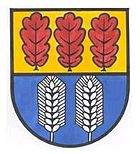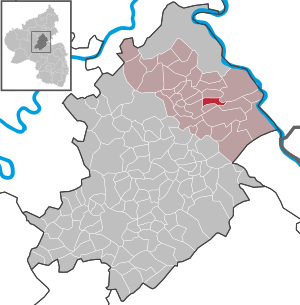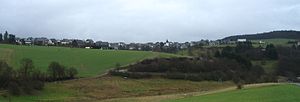Badenhard
| coat of arms | Germany map | |
|---|---|---|

|
Coordinates: 50 ° 7 ' N , 7 ° 38' E |
|
| Basic data | ||
| State : | Rhineland-Palatinate | |
| County : | Rhein-Hunsrück district | |
| Association municipality : | Hunsrück-Middle Rhine | |
| Height : | 435 m above sea level NHN | |
| Area : | 3 km 2 | |
| Residents: | 141 (Dec 31, 2019) | |
| Population density : | 47 inhabitants per km 2 | |
| Postal code : | 56291 | |
| Area code : | 06746 | |
| License plate : | SIM, GOA | |
| Community key : | 07 1 40 005 | |
| LOCODE : | DE BJ2 | |
| Association administration address: | Rathausstrasse 1 56281 Emmelshausen |
|
| Website : | ||
| Local Mayor : | Dirk Jost | |
| Location of the local community Badenhard in the Rhein-Hunsrück district | ||
Badenhard is a municipality in the Rhein-Hunsrück district in Rhineland-Palatinate . It belongs to the Hunsrück-Mittelrhein community .
Geographical location
Badenhard is located on a ridge in the east of the Hunsrück , between the Middle Rhine Valley and the A 61 motorway .
Neighboring communities are:
history
Badenhard was probably created in the 14th century. In old records there is talk of two farms that were located in the Badenhard district. One was the Schönhöller Hof , which was east of today's Badenhard, and the Preiserter Hof , which was west of the town. Both farms belonged to the Vogtei Pfalzfeld, which in turn belonged to the County of Katzenelnbogen . The village of Badenhard is believed to have emerged from these two farms. It used to be called Bahnert . Badenhard still has this name popularly today. The first document in which Badenhard is mentioned in a document comes from the year 1368. It also mentions the names of the first inhabitants. These are: Brück, Hofmann, Hilgert and Morschhäuser, which are still represented in the community today.
The local area, the Vogtei Pfalzfeld , was under the rule of the Count von Katzenelnbogen from the 13th to the end of the 15th century. Count Diether V. von Katzenelnbogen had the strong fortress Rheinfels built in the years 1245–46 , whereby the inhabitants of the Vogtei Pfalzfeld had to do labor. In the case of special occasions and emergencies, the villages of Badenhard and Utzenhain , as well as the entire Vogtei Pfalzfeld, consisting of 7 villages, had to provide castle services, as was the case with the siege of the fortress Rheinfels in 1692 and 1794. In the following centuries the rulers of Rheinfels changed several times. Be it through donations and inheritance, partly also through the effects of the war.
From the end of the 15th century to the beginning of the 17th century, the local community belonged to the Landgraves of Hessen-Kassel .
The Landgrave "Philip the Magnanimous" introduced the Reformation in the county of Katzenelnbogen in 1528 .
From 1626 to 1648 the Landgraves of Hessen-Darmstadt were the lords of the County of Katzenelnbogen.
During the Thirty Years' War , the local community suffered heavily from the occupation and the passing hordes and what they left behind was decimated by the plague in 1635. Entire villages are said to have died out. According to information at the time, the Vogtei Pfalzfeld should have comprised 40 families. Of these, 10 families are said to have remained and of 126 malters of oat hereditary interest (tax was paid in kind at that time), in 1655, 75 malteras were written as disposals of desolate goods. Those who survived the difficult times had fled into the woods for fear of the robbing and looting hordes. As a result, a great famine broke out in the local area in 1647. The chronicle reports that a field that was sold for 500 thalers in 1640 was exchanged for 5 loaves in 1647. People fed on roots. Cattle and even fallen cattle were moved. The city of St. Goar and the surrounding area suffered more in the last years of the war of 1759–1762 than in the entire Thirty Years War. In 1794 the French under General Jourdan occupied the entire left bank of the Rhine. In 1794 the siege of the fortress Rheinfels began. A report from the citizen of Badenhard, Johann Adam Brück, is available about this period: “In 1794, eight days before All Saints' Day , the first French came here on the way from 'Zalgert'. [Aldgund 3 km south of Badenhard] Fear and worry were everywhere. They moved through Badenhard to the street [St. Goar - Pfalzfeld], but then came back to the village. They went into the houses and asked for bread, but did not take anything by force. Two days later, a whole army encamped around the village. Now we had to hand over all of our food so that nothing was left for us. After a few days riders also came to the village. The people had to drive their cattle out of the stables so that the riders could shelter their horses, and they themselves fled to the Birkheimer Mühle [in the Niederbachtal]. The French had set up their provisions store in the 'Vorhäupten' [meadow ground below the village]. Slaughter was also carried out here. In the majority ox and hammel. The siege groups of the fortress Rheinfels were supplied from here. After the French captured the fortress, things got better. "
From the years 1794–1797 there is still a war cost calculation from the municipality of Badenhard. It amounts to 42,410 thalers and 21 1/2 crowns.
| Valleys | Crown | |
|---|---|---|
| Billing costs | 5.010 | |
| Damage from theft | 2,648 | 30th |
| Damage to land and forest | 5,200 | |
| Extortion from the community | 16,738 | 33 1/2 |
| Damage to gardens and fields | 2,250 | |
| Damage to warfare | 6,490 | |
| Damage to errands | 900 | |
| Damage to work on the fortresses at Rheinfels, Koblenz, Rhine and Moselle | 2,812 | |
| Damage to lost livestock and equipment in warfare | 76 | |
| Besides that | 286 | 57 |
| 42,410 | 120 1/2 |
The old church in Badenhard was built in 1741. It cannot be proven whether a church was here before, or whether people went to church in Pfalzfeld. Above the entrance door of the old church, the following sentence is carved into a wooden beam in Latin: "Keep your feet when you enter God's house and come so that you can hear." The beam was preserved despite the demolition of this church in 1909 and is still closed today see. The financial means for the construction of the new church came from a legacy of a local resident to the parish. The construction work was carried out by the Gottlob Bernhard company from St. Goar. On October 10, 1910, the new church was consecrated and given its purpose. The church with its 27 m high tower rises far beyond the townscape.
The old school, which was built in 1831 and which the children of both communities, Badenhard-Utzenhain, attended until 1930, was purchased by the Badenhard community in 1930 and used as a community center. In the years 1929–1930, the Badenhard-Utzenhain School Association had a new school built based on the criteria of the time. The builder was again the Gottlob Bernhard company from St. Goar. The previously mentioned old school, which was built in 1831, was not yet the first school building in Badenhard, because the chronicle tells of teachers who had worked there since 1750. One is mentioned who was also a tailor and linen weaver and also had land and cattle.
After the division of the Sankt Goar city forest on February 24, 1832, Badenhard von Sankt Goar received certain parts of the forest as property on May 31, 1835 , whereas you waived all other claims to the city forest. In addition, Badenhard received 48 wagons of leaves annually from the city forest for eternity.
Two von Badenhard and one man from Utzenhain took part in the 1866 campaigns. One from Badenhard was wounded by a shrapnel in the battle of Königgrätz.
Two men from Utzenhain and three from Badenhard took part in the war of 1870/71 . All came back with no harm.
The First World War also took its toll on both communities. All able-bodied men were drafted. Five men fell from Badenhard and seven did not return from Utzenhain. At that time there was a detachment of Russians prisoner of war in both places, helping those who stayed at home to till their fields and to harvest.
Even in World War II , all men fit for military service were drafted. Nine men fell from Badenhard, four are still missing. Seven men fell from Utzenhain and one more is missing. There were eight singing brothers among those killed and missing. In contrast to the First World War, a command of French prisoners of war was now forced to work in agriculture.
Neither place suffered from the direct effects of the war. Some bombs fell in the immediate vicinity. However, these only caused damage to fields and forests. On May 10, 1940, some German planes came back from bombing in the afternoon. An engine burned on an airplane. This plane dropped hundreds of semi-incendiary bombs about 600 m west of the village on a field, where most of them ignited. It then crashed in a forest near Halsenbach.
On March 4, 1945, American troops came from the Pfalzfeld direction via Birkheim, here in both places. Artillery had been deployed in the pastures below the village. This shelled German positions on the right bank of the Rhine. The local residents were rounded up in a few houses; They were only allowed to go home under guard for 1 1/2 hours in the morning and in the evening to feed. The last returnee from captivity came home at Christmas 1949.
After the Second World War, increasing mechanization did not stop at our village either. A little later, the operations in Badenhard-Utzenhain were adapted to industrial standards. Agriculture took off rapidly. The development of the townscape and the local area has also changed fundamentally in the years after the Second World War in both towns. Many new houses and economic buildings were built. With the support of the responsible local authority, both municipalities were able to expand the road network and sewerage. A new parish hall was built in Badenhard, which housed the parish bakery, a wine press room, a fire brigade's equipment room and the cattle scale. During a renovation in the 1990s, the rooms were made usable for other purposes. Above is a hall for 100 guests with a built-in stage. This room is also available to residents for family celebrations.
On September 26, 2010 the 100th anniversary of the Evangelical Church was held with the inauguration of the renovated village street. The proceeds of the celebration of € 622.66 were donated to a hospice community.
The Reinholds Pad hiking trail was inaugurated as part of a memorial ceremony on November 3, 2013 . This path leads through the oak forests parallel to the Niederbach.
With the approval and construction of 2 wind turbines in 2014, a contribution was made to the ecological, regenerative energy transition. As part of this construction project, Badenhard was also connected to a fast internet connection with fiber optic technology.
Denomination
The majority of the residents are Protestant .
politics
Municipal council
The council in Badenhard consists of six council members, who in the local elections on May 26, 2019 in a majority vote were elected, and the honorary mayor as chairman.
mayor
Local mayor is Dirk Jost. In the local elections on May 26, 2019, he was confirmed in office with 73.75% of the votes.
coat of arms
| Blazon : "In a divided shield above in gold three red oak leaves side by side, below in blue two silver ears of corn." | |
| Justification of the coat of arms: The oak leaves indicate the deciduous forests, the ears of corn indicate agriculture. The metals and colors of the coat of arms are those of the Katzenellenbogen and those of the Landgraviate of Hesse , to whose territory Badenhard once belonged. |
societies
Mixed choir “Singer greeting” Badenhard-Birkheim-Utzenhain e. V.
The choir was founded in 1922 by the junior teacher Valentin Krämer. Krämer was born in Mengigart in 1898 as the son of the local village school teacher. Immediately after his employment as a teacher at the school in Badenhard, he and a few students laid the foundation stone for the choral society that still exists today. In 1985, what had previously been a purely male choir became a mixed choir, which is now conducted by Bernhard Münnig from Birkheim.
Football recreational team Dreiländerkicker
Founded in 1979, like the choir, it consists of residents from the three villages of Badenhard, Birkheim and Utzenhain. In 2018 the Dreiländerkicker became a registered association.
Attractions
- Evangelical Church from 1910
- Reinhold's path
See also:
traffic
Badenhard is only a few kilometers away from the A 61 .
The Emmelshausen or Sankt Goar train stations are within a 10 km radius .
Personalities
The font designer Hans Schmidt lives in Badenhard .
literature
- Literature about Badenhard in the Rhineland-Palatinate State Bibliography
Web links
Individual evidence
- ↑ State Statistical Office of Rhineland-Palatinate - population status 2019, districts, communities, association communities ( help on this ).
- ^ The Regional Returning Officer RLP: City Council Election 2019 Badenhard. Retrieved October 5, 2019 .
- ↑ The regional returning officer RLP: direct elections 2019. see Hunsrück-Mittelrhein, Verbandsgemeinde, second line of results. Retrieved October 5, 2019 .
- ↑ Homepage Birkheim. Retrieved May 13, 2016 .






